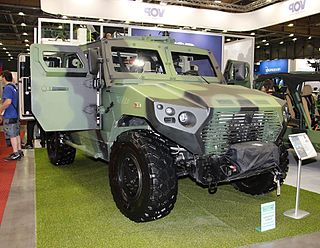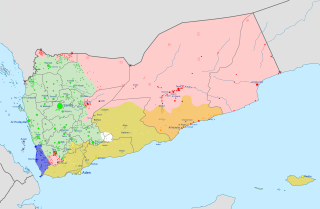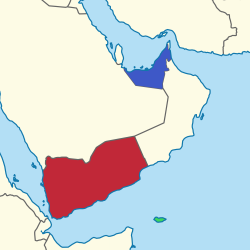
The 'United Arab Emirates Armed Forces are the armed forces of the United Arab Emirates. They are also occasionally referred to as "Little Sparta", a nickname that was given by former United States Marine Corps General and Secretary of Defense James Mattis, due to their active and effective military role and power projection in the surrounding region compared to their relative size.

Socotra or Saqatri is an island of Yemen in the Indian Ocean. Lying between the Guardafui Channel and the Arabian Sea and near major shipping routes, Socotra is the largest of the four islands in the Socotra archipelago. Since 2013, the archipelago has constituted the Socotra Governorate.

Socotra Airport is an airport in Socotra, Yemen. It is the only commercial airport that serves the Yemeni island of Socotra in the Arabian Sea and its capital town of Hadibu.
The history of Socotra describes the cultures, events, peoples and strategic relevance for sea trade of what is Socotra, an island of the Republic of Yemen, currently under control of the United Arab Emirates (UAE)-backed Southern Transitional Council, a secessionist participant in Yemen's ongoing civil war. Lying between the Guardafui Channel and the Arabian Sea and near major shipping routes, Socotra is the largest of the four islands in the Socotra archipelago.

The United Arab Emirates Army (UAEA) is the land force branch of the United Arab Emirates Armed Forces.

The Nimr is a family of all-terrain military armored personnel carrier (APC) vehicles, co-developed with Military Industrial Company and produced by Nimr LLC in the United Arab Emirates. The Nimr is designed specifically for military operations in the harsh desert climates found in the Middle East.

Turkey and the United Arab Emirates share extensive cultural, military and economic ties, but relations have substantially deteriorated since Arab Spring, and later started to recover in the recent years.

Relations between the neighboring countries of Iran and the United Arab Emirates (UAE) are deeply historic, dating back centuries prior to the establishment of the modern-day United Arab Emirates; however today are shaky and unpredictable. Both the countries maintain diplomatic relations with each other, having embassies in each other's capitals.

Bilateral ties exist between Australia and the United Arab Emirates. The UAE maintains an embassy in Canberra whilst Australia has an embassy in Abu Dhabi and a consulate-general in Dubai.
The military history of the United Arab Emirates describes the military history of the United Arab Emirates Armed Forces. Prior to the union of the emirates, different tribal confederations formed the de facto military force which was dominant in the area now known as the United Arab Emirates. The Bani Yas and Al Qawasim were the most significant of those tribal confederations. The official formation of the military began with the formation of the Truical Oman Levies by the British Empire on 11 May 1951 as the area was under a British protectorate.

Saudi Arabia and the United Arab Emirates (UAE) are neighbouring countries in the Middle East and Persian Gulf region, and share extensive political and cultural ties. Saudi Arabia maintains an embassy in Abu Dhabi and a consulate in Dubai of the UAE, while the UAE has an embassy in Riyadh and a consulate in Jeddah, Saudi Arabia.

The Socotra Archipelago or Suqutra is officially one of the governorates of Yemen. It is composed of the Guardafui Channel's archipelago of Socotra.

The Yemeni civil war is an ongoing multilateral civil war that began in late 2014 mainly between the Rashad al-Alimi-led Presidential Leadership Council and the Mahdi al-Mashat-led Supreme Political Council, along with their supporters and allies. Both claim to constitute the official government of Yemen.

On 26 March 2015, Saudi Arabia, leading a coalition of nine countries from West Asia and North Africa, launched an intervention in Yemen at the request of Yemeni president Abdrabbuh Mansur Hadi, who had been ousted from the capital, Sanaa, in September 2014 by Houthi insurgents during the Yemeni Civil War. Efforts by the United Nations to facilitate a power sharing arrangement under a new transitional government collapsed, leading to escalating conflict between government forces, Houthi rebels, and other armed groups, which culminated in Hadi fleeing to Saudi Arabia shortly before it began military operations in the country.

Extremely Severe Cyclonic Storm Chapala was a powerful tropical cyclone that caused moderate damage in Somalia and Yemen during November 2015. Chapala was the third named storm of the 2015 North Indian Ocean cyclone season. It developed as a depression on 28 October off western India, and strengthened a day later into a cyclonic storm. Chapala then rapidly intensified amid favorable conditions. On 30 October, the India Meteorological Department (IMD) estimated that Chapala attained peak three-minute sustained winds of 215 km/h (135 mph). The American-based Joint Typhoon Warning Center (JTWC) estimated sustained winds of 240 km/h (150 mph), making Chapala among the strongest cyclones on record in the Arabian Sea. After peak intensity, Chapala skirted the Yemeni island of Socotra on 1 November, becoming the first hurricane-force storm there since 1922. High winds and heavy rainfall resulted in an island-wide power outage, and severe damage was compounded by Cyclone Megh, which struck Yemen a week later. Chapala means 'scrutiny' in Bengali.

Extremely Severe Cyclonic Storm Megh is regarded as the worst tropical cyclone to ever strike the Yemeni island of Socotra, causing additional destruction there after Cyclone Chapala hit the same island. Megh formed on November 5, 2015, in the eastern Arabian Sea, and followed a path similar to Chapala. After moving northward, the cyclone turned to the west, and fueled by warm water temperatures, it quickly intensified. On November 7, the storm developed an eye in the center and began to rapidly intensify into a mature cyclone. By the next day, the India Meteorological Department estimated peak 3 minute sustained winds of 175 km/h (110 mph), and the American-based Joint Typhoon Warning Center estimated 1 minute winds of 205 km/h (125 mph). Shortly thereafter, the cyclone brushed the northern coast of Socotra. The storm steadily weakened thereafter, especially after it skirted the northern Somalia coast. After entering the Gulf of Aden, Megh turned to the west-northwest and struck southwestern Yemen on 10 November as a deep depression, dissipating shortly thereafter.
Events in the year 2018 in Yemen.

The siege of Al Hudaydah, codenamed Operation Golden Victory, was a major Saudi-led coalition assault on the port city of Al Hudaydah in Yemen. It was spearheaded by the United Arab Emirates and Saudi Arabia and has been considered as the largest battle since the start of Saudi Arabian-led intervention in Yemen in 2015.

The UAE and Yemen have a complex and strained relationship, as the UAE has played a significant role in regional politics in Yemen, and has at various points been an adversary of the country, as the UAE's involvement in Yemen, for example the United Arab Emirates takeover of Socotra, and its support for the Southern Transitional Council, a secessionist organization in Southern Yemen, has been a source of tension between the two countries, and has contributed to the ongoing conflict and humanitarian crisis in the country. Furthermore, the UAE has been involved in other efforts in Yemen that have been controversial. The country has been accused of backing local militias and separatist groups that have sought to gain more autonomy or independence from the central government. Some critics have accused the UAE of using these groups to further its own interests in the region, rather than working towards a broader peace and stability in Yemen.
The 2022 Abu Dhabi attack was an attack against three oil tanker trucks and an under construction airport extension infrastructure in Abu Dhabi, United Arab Emirates conducted by the Houthi movement using drones and missiles. Although several missiles and drones were intercepted, 3 civilians were killed and 6 were injured by a drone attack.
















